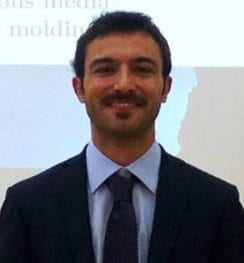
Luca Bergamasco obtained a Master degree in Mechanical Engineering from Politecnico di Torino, with a thesis made at the University of Edinburgh, Scotland (UK). He received a PhD in Fluid Mechanics from the University of Zaragoza (Spain), and was subsequently enrolled as a post-doctoral researcher at the Sorbonne University in Paris (France). He is currently a tenure-track Assistant Professor at the Department of Energy, Politecnico di Torino (Italy).
Dr. Bergamasco’s research focuses on modeling transport phenomena at different scales, from atomistic to continuum, using both physics-based and data-driven (AI) approaches. His application areas of interest span mainly the (renewable) energy sector, and include especially innovative materials for solar energy conversion and storage.
He has published 35+ articles in peer-reviewed international journals. In 2023, he was awarded a fellowship from the Holland Research School of Molecular Chemistry for the project "Soap-film based electrochemical water splitting", recognizing the innovation potential in the field of solar energy conversion into fuels and energy sustainability.
Bridging physics and AI: the potential of data-driven approaches for advanced energy materials and solar fuels
While physics-based modelling approaches provide strong foundations to understand materials properties, their applicability becomes limited or cumbersome when dealing with complex multi-scale problems. In these cases, data-driven modelling approaches can offer valuable complementary or alternative approaches. In this talk, two practical examples where traditional physics-based modelling faces limitations will be discussed, both within the context of innovative technologies for solar energy conversion into fuels [1,2,3]. For each example, the potential of data-driven and/or AI-guided approaches via, e.g. Deep Learning [4] and Sequential Learning [5] methods, will be discussed.
References
[1] Falciani, G., Bergamasco, L., Bonke, S. A., Sen, I., & Chiavazzo, E. (2023). A novel concept of photosynthetic soft membranes: a numerical study. Discover Nano, 18(1), 9.
[2] Kaul, N., Bergamasco, L., Song, H., Varkevisser, T., Amati, A., Falciani, G., ... & Hammarström, L. (2024). Realizing Symmetry-Breaking Architectures in Soap Films. Physical Review Letters, 132(2), 028201.
[3] Bonke, S. A., Trezza, G., Bergamasco, L., Song, H., Rodríguez-Jiménez, S., Hammarström, L., ... & Reisner, E. (2024). Multi-Variable Multi-Metric Optimization of Self-Assembled Photocatalytic CO2 Reduction Performance Using Machine Learning Algorithms. Journal of the American Chemical Society.
[4] Casini, M., De Angelis, P., Chiavazzo, E., & Bergamasco, L. (2024). Current trends on the use of deep learning methods for image analysis in energy applications. Energy and AI, 15, 100330.
[5] Trezza, G., Bergamasco, L., Fasano, M., & Chiavazzo, E. (2022). Minimal crystallographic descriptors of sorption properties in hypothetical MOFs and role in sequential learning optimization. npj Computational Materials, 8(1), 123.